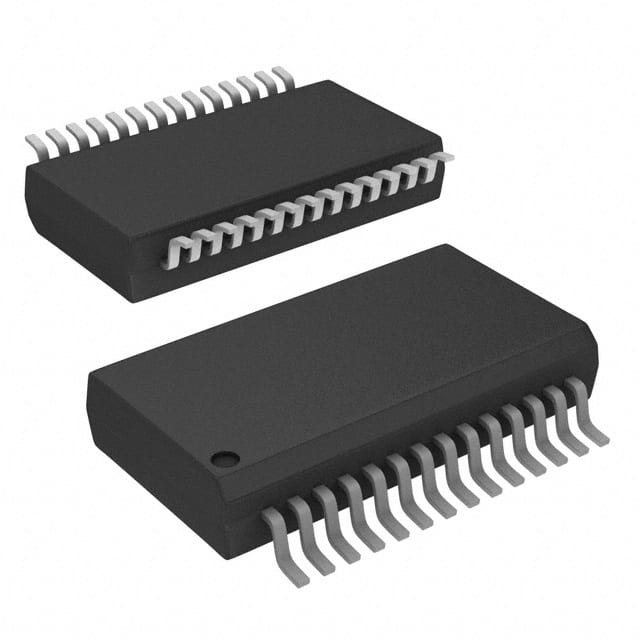Lihat spesifikasi untuk detail produk.

PIC16C62AT-04E/SS
Introduction
The PIC16C62AT-04E/SS is a microcontroller belonging to the PIC16 family of microcontrollers developed by Microchip Technology. This entry provides an overview of the product, including its category, use, characteristics, package, essence, packaging/quantity, specifications, detailed pin configuration, functional features, advantages and disadvantages, working principles, detailed application field plans, and alternative models.
Category and Use
The PIC16C62AT-04E/SS belongs to the category of 8-bit microcontrollers and is widely used in embedded systems, consumer electronics, industrial control, and automotive applications. Its versatile nature makes it suitable for a wide range of applications, from simple control tasks to complex automation systems.
Characteristics
The PIC16C62AT-04E/SS is known for its low power consumption, high performance, and versatility. It operates at a clock speed of 4 MHz and has a wide operating voltage range, making it suitable for battery-powered and low-power applications. Additionally, it offers a rich set of peripherals including timers, communication interfaces, and analog-to-digital converters, enhancing its capability to interface with various external devices.
Package and Essence
The PIC16C62AT-04E/SS is available in a SSOP (Shrink Small Outline Package) which provides a compact form factor while ensuring ease of assembly onto printed circuit boards. Its essence lies in its ability to provide a cost-effective and efficient solution for embedded control applications.
Packaging/Quantity
The PIC16C62AT-04E/SS is typically packaged in reels containing a specific quantity, usually ranging from hundreds to thousands, depending on the manufacturer's specifications.
Specifications
- Operating Voltage: 2.5V to 5.5V
- Maximum Clock Speed: 4 MHz
- Flash Memory: 3.5 KB
- RAM: 128 bytes
- I/O Pins: 22
- Communication Interfaces: USART, SPI, I2C
- Timers: 2 x 8-bit, 1 x 16-bit
- Analog-to-Digital Converter: 8 channels, 10-bit resolution
Detailed Pin Configuration
The PIC16C62AT-04E/SS features a total of 28 pins, each serving specific functions such as digital I/O, analog input, power supply, and communication interfaces. The pinout diagram and detailed pin descriptions can be found in the product datasheet.
Functional Features
The microcontroller offers a wide range of functional features including versatile I/O capabilities, multiple communication interfaces, integrated analog-to-digital conversion, and flexible timer modules. These features enable the microcontroller to interface with various sensors, actuators, and communication devices, making it suitable for diverse applications.
Advantages and Disadvantages
Advantages: - Low power consumption - Versatile peripheral set - Wide operating voltage range - Compact form factor - Cost-effective solution
Disadvantages: - Limited processing power for complex algorithms - Limited memory for large-scale applications
Working Principles
The PIC16C62AT-04E/SS operates based on the Harvard architecture, featuring separate program and data memories. It executes instructions fetched from program memory and manipulates data stored in data memory to perform various tasks. The microcontroller follows a sequential execution model, processing instructions one after the other to accomplish the desired functionality.
Detailed Application Field Plans
The PIC16C62AT-04E/SS finds extensive use in applications such as: - Home automation systems - Industrial control systems - Sensor interfacing and data acquisition - Motor control - Consumer electronics
Alternative Models
For applications requiring higher processing power or additional features, alternative models such as PIC18F series microcontrollers from Microchip Technology can be considered. These models offer enhanced performance, larger memory, and advanced peripherals, catering to more demanding applications.
In conclusion, the PIC16C62AT-04E/SS microcontroller serves as a versatile and cost-effective solution for a wide range of embedded control applications. With its low power consumption, rich peripheral set, and compact form factor, it continues to be a popular choice for designers seeking efficient solutions for their projects.
[Word count: 611]
Sebutkan 10 pertanyaan dan jawaban umum terkait penerapan PIC16C62AT-04E/SS dalam solusi teknis
What is the operating voltage range of PIC16C62AT-04E/SS?
- The operating voltage range of PIC16C62AT-04E/SS is 2.5V to 5.5V.What is the maximum clock frequency supported by PIC16C62AT-04E/SS?
- PIC16C62AT-04E/SS supports a maximum clock frequency of 4 MHz.Can PIC16C62AT-04E/SS be used in battery-powered applications?
- Yes, PIC16C62AT-04E/SS can be used in battery-powered applications due to its low operating voltage range.Does PIC16C62AT-04E/SS have built-in analog-to-digital conversion (ADC) capability?
- No, PIC16C62AT-04E/SS does not have built-in ADC capability.What are the communication interfaces supported by PIC16C62AT-04E/SS?
- PIC16C62AT-04E/SS supports serial communication interfaces such as UART and SPI.Is PIC16C62AT-04E/SS suitable for temperature sensing applications?
- Yes, PIC16C62AT-04E/SS can be used in temperature sensing applications with external temperature sensors.Can PIC16C62AT-04E/SS be programmed using a high-level language like C?
- Yes, PIC16C62AT-04E/SS can be programmed using high-level languages like C using appropriate compilers.What are the available I/O pins on PIC16C62AT-04E/SS?
- PIC16C62AT-04E/SS has a total of 22 I/O pins available for interfacing with external components.Is PIC16C62AT-04E/SS suitable for motor control applications?
- Yes, PIC16C62AT-04E/SS can be used for simple motor control applications with proper interfacing circuitry.Can PIC16C62AT-04E/SS be used in industrial automation applications?
- Yes, PIC16C62AT-04E/SS can be used in various industrial automation applications such as sensor interfacing and control systems.

